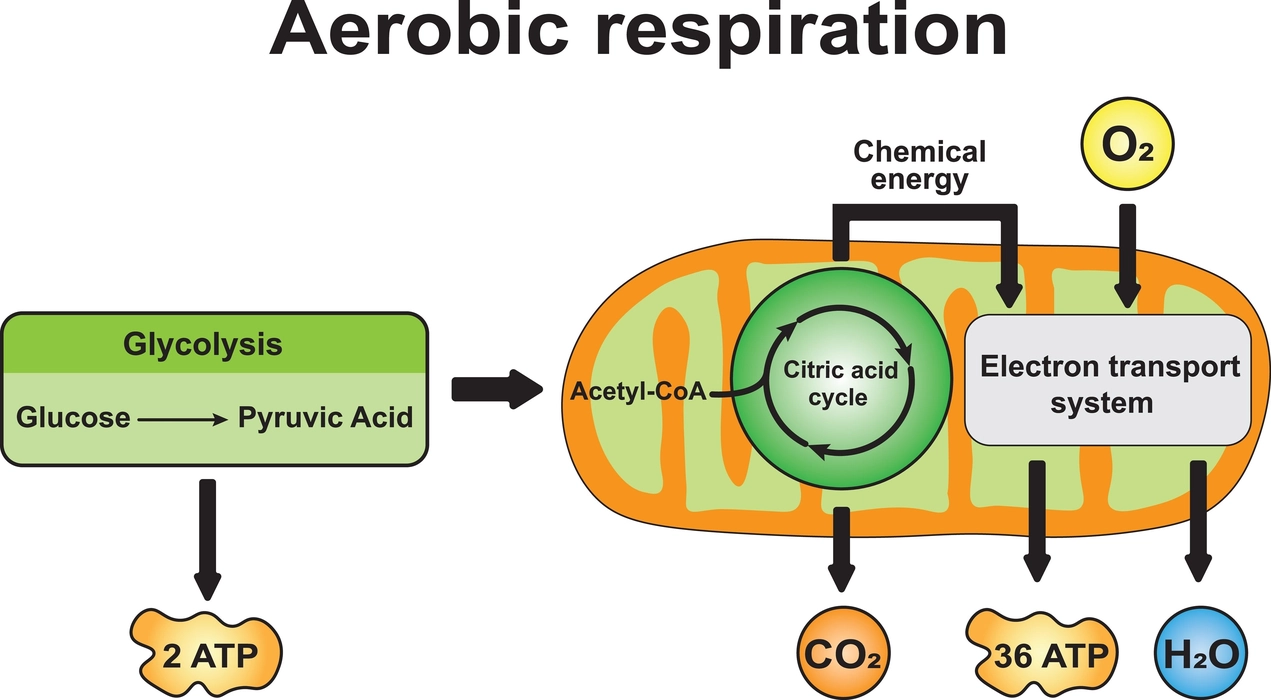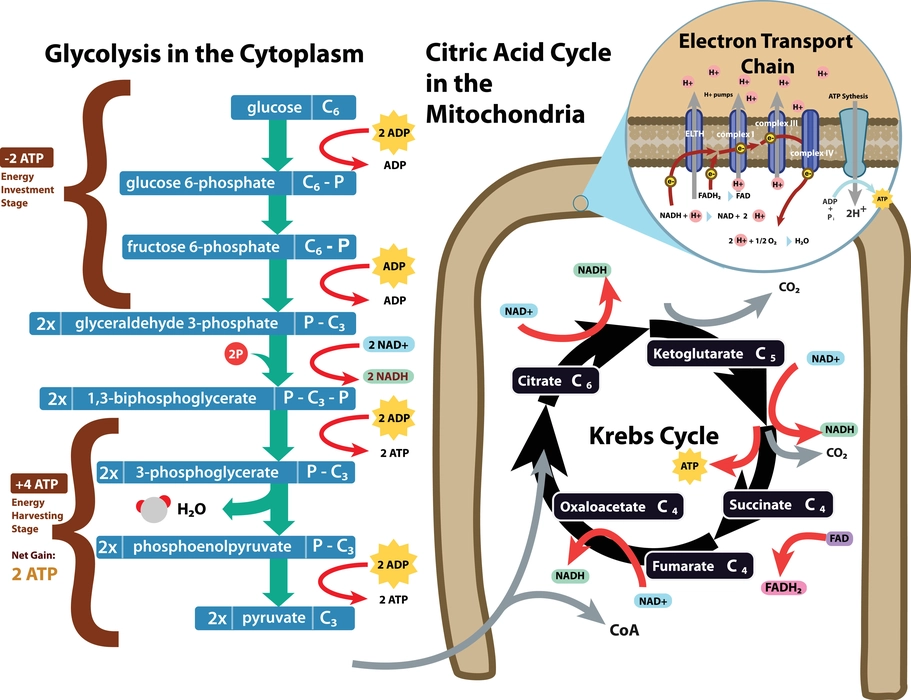Introduction
All living things require energy to carry out their many tasks, such as breathing, growth, metabolism, and movement. Because of this, cells need a constant flow of energy to support their development, maintenance, and repair. Although the sun is a good source of energy, not all types of life can use it directly. The process by which all the cells in living things produce energy is called cellular respiration. The body receives energy via the breakdown of glucose, whether oxygen is present or not.
What is Aerobic Respiration?
During aerobic respiration, glucose present in the food is converted into water and \(C{O_2}\). It releases energy in the form of ATP (Adenosine triphosphate) and each ATP hydrolysis gives 7.3 kcal/mol. Through this catabolic process, food is converted into energy that is needed for various body functions. Eukaryotes, prokaryotes, and plants undergo this process. The process is also known as oxidative metabolism.

Aerobic Respiration Equation
When glucose is completely burned, carbon dioxide and water are released with energy as a byproduct. The overall equation of aerobic respiration is given here,
\[{{\bf{C}}_6}{{\bf{H}}_{12}}{{\bf{O}}_6}\left( {{\bf{Glucose}}} \right) + {\bf{6}}{{\bf{O}}_2}({\bf{Oxygen}}){\bf{6C}}{{\bf{O}}_2}\left( {{\bf{Carbon}}{\rm{ }}{\bf{dioxide}}} \right) + {\bf{6}}{{\bf{H}}_2}{\bf{O}}\left( {{\bf{Water}}} \right) + {\bf{Energy}}\]
About 2900 kJ are released and transformed into ATP, which is used for several purposes.
Steps Involved in Aerobic Respiration
The process of aerobic respiration involves four major steps with intermediate reactions. Those are as follows.

Glycolysis
Initially, glycolysis was derived from the Greek words glyco (meaning sugar or sweet) and lysis (meaning dissolution). As a universal sequential reaction, it occurs in both aerobic and anaerobic respiration in the cytosol of a cell.
- Two ATP molecules and two NADH molecules are produced when one glucose (glycogen) molecule breaks down into two molecules of three carbon compounds pyruvates.
- NADH (NAD+H) is the reduced form of NAD (nicotinamide adenine dinucleotide), which is the electron acceptor. The further process of aerobic respiration is carried out by these molecules.
- Glycolysis is also called the “Embden- Meyerhof-Parnas” (EMP) Pathway.
Pyruvate oxidation (linking reaction)
- During this linking reaction, two stages are connected so that the end product of glycolysis can be used in the citric acid cycle.
- The enzyme pyruvate translocase assists in the entry of the two pyruvate molecules into the mitochondrial matrix.
- Acetyl-CoA is formed by the oxidation of pyruvate by the Pyruvate dehydrogenase complex.
Citric acid/Krebs cycle
- Citric acid is produced by combining Acetyl-CoA with four-carbon oxaloacetate.
- ATP and carbon dioxide are produced sequentially, along with NADH and FADH reduced forms.
- It is also known as the TCA cycle (tricarboxylic acid cycle) because citric acid has three carboxyl groups.
Electron Transport Chain (ETC)
- This last stage of aerobic respiration occurs in the mitochondria.
- ETC is a cluster of proteins that transports electrons across a membrane into mitochondria and generates a significant amount of ATP.
- One glucose molecule is broken down into 32 molecules of ATP during this aerobic respiration process.
Examples of Aerobic Respiration
- All multicellular species, including humans, birds, animals, and insects, partake in aerobic respiration. The glucose in the food breaks down in the presence of oxygen and releases energy.
- It occurs in the majority of higher plants also.
Do all human cells carry out aerobic respiration?
All the cells in the human body are capable of doing aerobic respiration. However, during intense physical activity such as running, jogging, jumping rope, aerobic dance, and cycling up hills, where low oxygen levels result in low energy levels in the body, muscle cells can do anaerobic respiration. To obtain energy, the muscle cells resort to anaerobic respiration.
Aerobic Respiration in Plants
- In the cytosol and mitochondria of plant cells, aerobic respiration takes place.
- Oxygen and simple carbohydrates such as glucose function as reactants.
- The stomata, which are pores in the epidermis of a plant’s stem and leaves, allow oxygen to enter the plant while it is engaged in aerobic respiration.
- With the assistance of ambient oxygen, glucose completely breaks down to produce carbon dioxide and water.
- Additionally, a significant amount of energy is released in the form of ATP.
Significance of Aerobic Respiration
- Living things require ATP that is produced during aerobic respiration to participate in metabolic processes and perform necessary bodily functions.
- Carbon dioxide, the by-product of aerobic respiration, can be used for photosynthesis in green plants.
- Water, carbon dioxide, and sunlight can be combined during photosynthesis to produce food for plants.
- Cell division also uses the energy that is generated during respiration.
- The intermediate compounds, organic acids, and coenzymes are useful for organic activities.
Summary
During aerobic respiration, glucose present in the food is converted into water and \(C{O_2}\). When glucose is completely burned, carbon dioxide and water are released as by-products along with energy. The process of aerobic respiration involves four major steps with intermediate reactions. Those are glycolysis, pyruvate oxidation, Krebs’s cycle, and the electron transport chain. In the cytosol and mitochondria of plant cells, aerobic respiration takes place. Carbon dioxide, the by-product of aerobic respiration, can be used for photosynthesis in green plants.
Frequently Asked Questions
1. Which respiration process transforms glucose into energy more efficiently, and why?
Ans. The 36 ATP molecules are produced by aerobic cell respiration. The efficiency of aerobic cell respiration is about 18 times greater than that of anaerobic cell respiration. Due to the entire conversion of glucose into \(C{O_2}\) and energy, there is a significant amount of energy production.
2. What are ATP and NADH?
Ans. Adenosine triphosphate, or ATP, is an energy-carrying molecule that fuels the metabolism of living things. Nicotinamide adenine dinucleotide, or NAD, is an electron acceptor; its reduced version is called NADH.
3. What is the difference between breathing and cellular respiration?
Ans. While cellular respiration is a process of obtaining energy to carry out various bodily tasks, breathing is a process of exchanging gases between the environment and an organism.
4. Does anaerobic respiration takes place in the human cells?
Ans. During heavy workouts, anaerobic respiration takes place in the muscles. Since there is no complete breakdown of glucose in anaerobic respiration, the energy liberated is less than that of aerobic respiration. The muscles accumulate lactic acid when you exercise vigorously. Then, this lactic acid oxidizes to produce water and \(C{O_2}\).
5. Where does oxygen-assisted respiration occur within the cell?
Ans. The cytoplasm of the cell serves as the starting point for aerobic respiration, which concludes in the mitochondria. The mitochondria are where the majority of aerobic respiration’s reactions take place.

